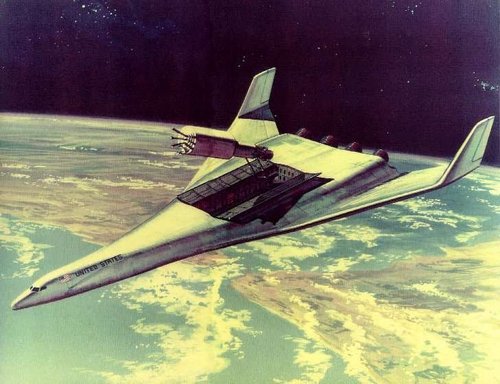The other day I was looking at some space proposals from the past and I stumbled upon this beautiful SSTO. I have only been able to find one source that gave some details about it and I'm very much hoping that you guys can help get more details/drawings on this proposal.

- "The ”Windjammer” was an early 1970s HTHL SSTO proposal initially developed by Boeing & North American Rockwell and later refined by Len Cormier in 1970-73. It would have been launched from a ground accelerator sled. Salkeld used it as a starting point for his own tripropellant HTHL SSTO analyses and also published some preliminary trade studies on the merits and drawbacks of vertical vs. horizontal launch/landing for single-stage-to-orbit vehicles. He concluded that mixed mode propulsion would produce gains of over 100% in payload:dry mass ratio for VTVL SSTOs and reductions of over 65% in propellant volume and >20% in dry weight. HTHL SSTOs do not benefit as much since the planform area must remain low enough, the sharp reduction in propellant volume might permit tankage (e.g. hydrocarbon fuel "wet wing" tanks) and structural simplifications. In general, vertically launched SSTOs have better growth potential than HTHLs, but they would require new engines (plug nozzle aerospike and/or tripropellant propulsion) whereas HTHL SSTOs such as the Windjammer in principle could use SSMEs. HTHL would however require new advanced structures and a ground accelerator rather than Shuttle-level technology (VTHL) or ballistic technologies (VTVL) and launch facilities. Vertically launched SSTOs could in principle be launched in any direction (range safety permitting) whereas HTHLs might be restricted to certain orbital inclinations if the vehicle has to make a sharp turn shortly after launch. VTVL SSTO might possibly generate less noise on return & landing while HTHLs could face some limitations during ascent to orbit. Winged HTHL SSTOs have good crossrange capabilities, low reentry planform loading and high subsonic landing L/D. VTHL SSTO also offers moderately good aerodynamics & maneuvering capabilities while rocket powered vertical landing is comparatively unproven. VTVL SSTOs however have no self ferry capability unless the main rocket propulsion system is used and the aerospike engine+actively cooled TPS represents a significant development risk. Consequently, Salkeld rejected the VTVL SSTO for challenging missions such a suborbital freight delivery."



